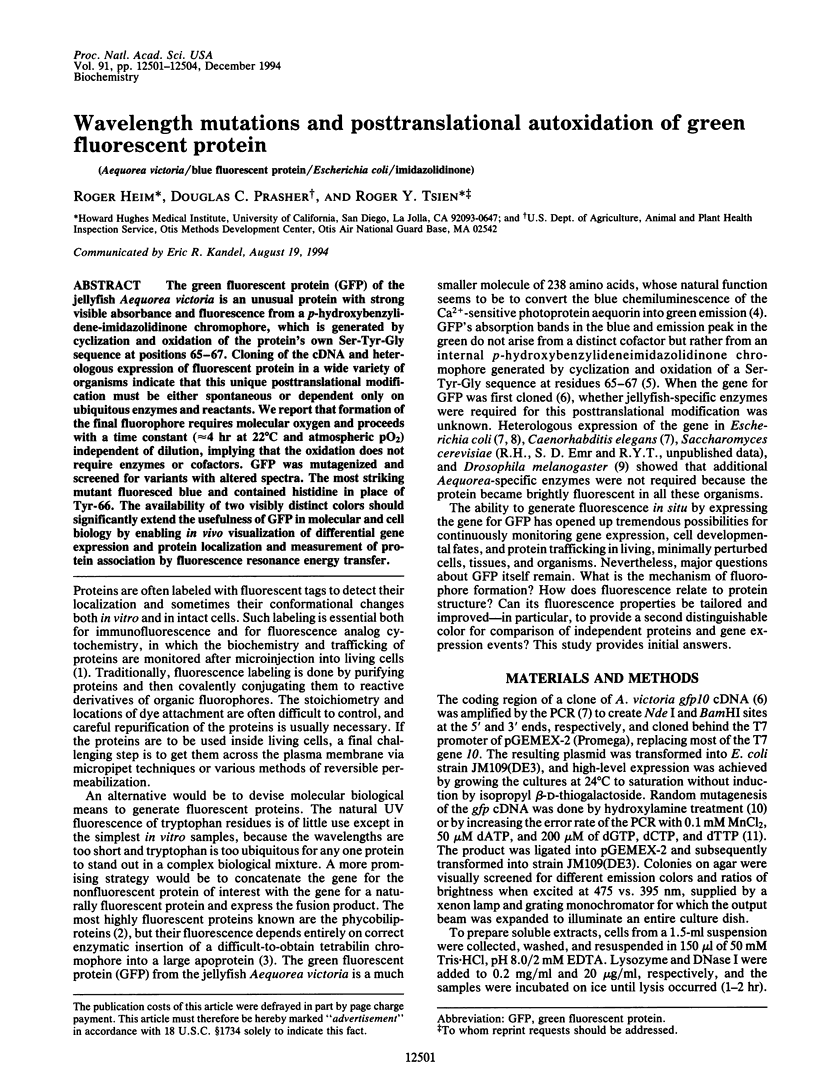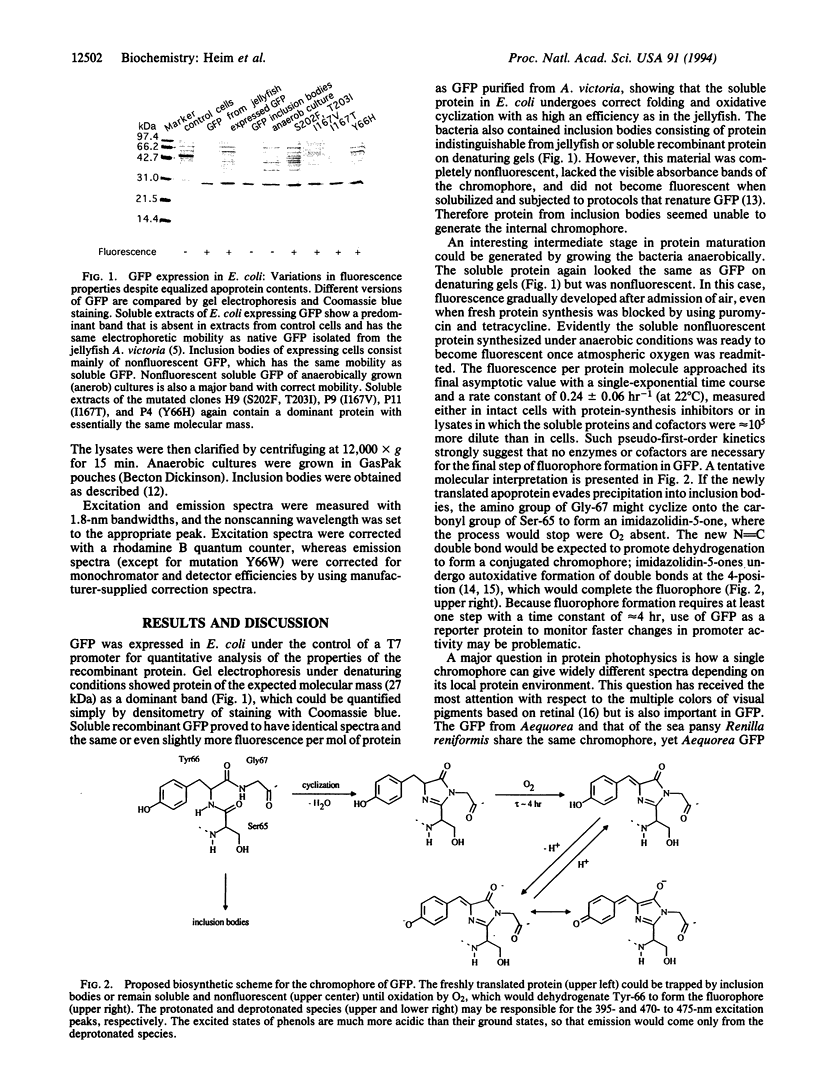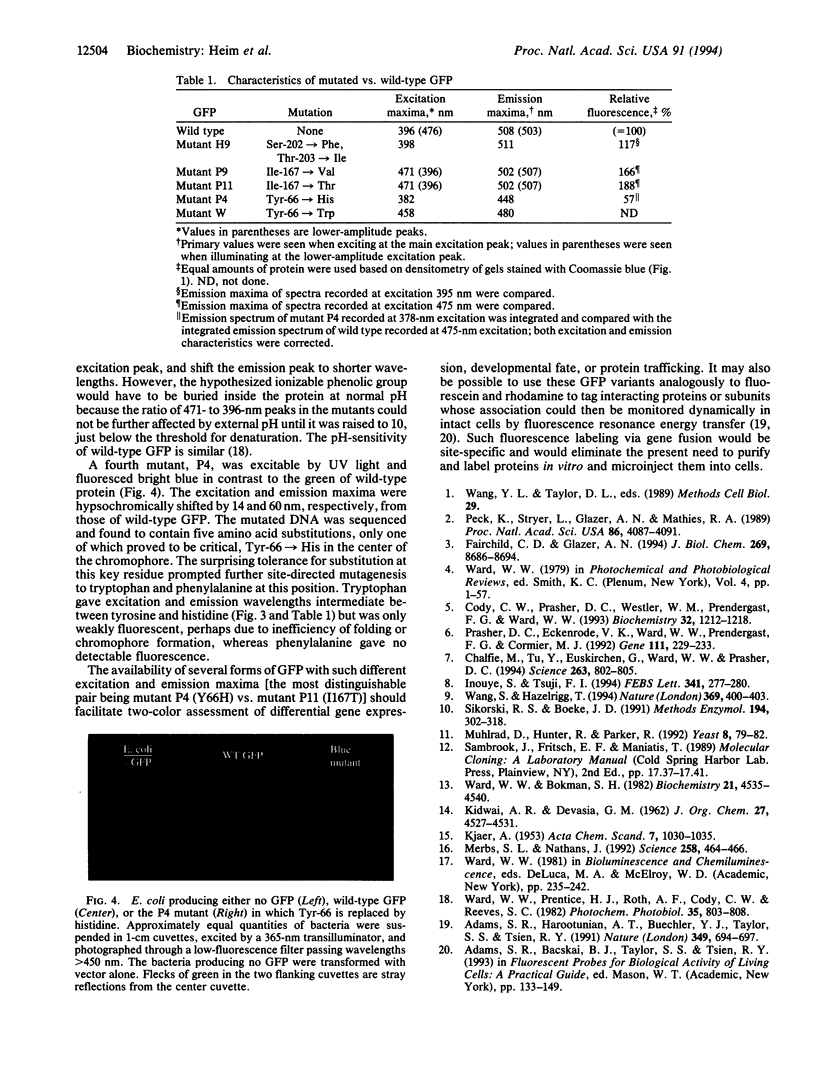Abstract
The green fluorescent protein (GFP) of the jellyfish Aequorea victoria is an unusual protein with strong visible absorbance and fluorescence from a p-hydroxybenzylidene-imidazolidinone chromophore, which is generated by cyclization and oxidation of the protein's own Ser-Tyr-Gly sequence at positions 65-67. Cloning of the cDNA and heterologous expression of fluorescent protein in a wide variety of organisms indicate that this unique posttranslational modification must be either spontaneous or dependent only on ubiquitous enzymes and reactants. We report that formation of the final fluorophore requires molecular oxygen and proceeds with a time constant (approximately 4 hr at 22 degrees C and atmospheric pO2) independent of dilution, implying that the oxidation does not require enzymes or cofactors. GFP was mutagenized and screened for variants with altered spectra. The most striking mutant fluoresced blue and contained histidine in place of Tyr-66. The availability of two visibly distinct colors should significantly extend the usefulness of GFP in molecular and cell biology by enabling in vivo visualization of differential gene expression and protein localization and measurement of protein association by fluorescence resonance energy transfer.
Full text
PDF



Images in this article
Selected References
These references are in PubMed. This may not be the complete list of references from this article.
- Adams S. R., Harootunian A. T., Buechler Y. J., Taylor S. S., Tsien R. Y. Fluorescence ratio imaging of cyclic AMP in single cells. Nature. 1991 Feb 21;349(6311):694–697. doi: 10.1038/349694a0. [DOI] [PubMed] [Google Scholar]
- Chalfie M., Tu Y., Euskirchen G., Ward W. W., Prasher D. C. Green fluorescent protein as a marker for gene expression. Science. 1994 Feb 11;263(5148):802–805. doi: 10.1126/science.8303295. [DOI] [PubMed] [Google Scholar]
- Cody C. W., Prasher D. C., Westler W. M., Prendergast F. G., Ward W. W. Chemical structure of the hexapeptide chromophore of the Aequorea green-fluorescent protein. Biochemistry. 1993 Feb 9;32(5):1212–1218. doi: 10.1021/bi00056a003. [DOI] [PubMed] [Google Scholar]
- Fairchild C. D., Glazer A. N. Oligomeric structure, enzyme kinetics, and substrate specificity of the phycocyanin alpha subunit phycocyanobilin lyase. J Biol Chem. 1994 Mar 25;269(12):8686–8694. [PubMed] [Google Scholar]
- Inouye S., Tsuji F. I. Aequorea green fluorescent protein. Expression of the gene and fluorescence characteristics of the recombinant protein. FEBS Lett. 1994 Mar 21;341(2-3):277–280. doi: 10.1016/0014-5793(94)80472-9. [DOI] [PubMed] [Google Scholar]
- Merbs S. L., Nathans J. Absorption spectra of the hybrid pigments responsible for anomalous color vision. Science. 1992 Oct 16;258(5081):464–466. doi: 10.1126/science.1411542. [DOI] [PubMed] [Google Scholar]
- Muhlrad D., Hunter R., Parker R. A rapid method for localized mutagenesis of yeast genes. Yeast. 1992 Feb;8(2):79–82. doi: 10.1002/yea.320080202. [DOI] [PubMed] [Google Scholar]
- Peck K., Stryer L., Glazer A. N., Mathies R. A. Single-molecule fluorescence detection: autocorrelation criterion and experimental realization with phycoerythrin. Proc Natl Acad Sci U S A. 1989 Jun;86(11):4087–4091. doi: 10.1073/pnas.86.11.4087. [DOI] [PMC free article] [PubMed] [Google Scholar]
- Prasher D. C., Eckenrode V. K., Ward W. W., Prendergast F. G., Cormier M. J. Primary structure of the Aequorea victoria green-fluorescent protein. Gene. 1992 Feb 15;111(2):229–233. doi: 10.1016/0378-1119(92)90691-h. [DOI] [PubMed] [Google Scholar]
- Sikorski R. S., Boeke J. D. In vitro mutagenesis and plasmid shuffling: from cloned gene to mutant yeast. Methods Enzymol. 1991;194:302–318. doi: 10.1016/0076-6879(91)94023-6. [DOI] [PubMed] [Google Scholar]
- Wang S., Hazelrigg T. Implications for bcd mRNA localization from spatial distribution of exu protein in Drosophila oogenesis. Nature. 1994 Jun 2;369(6479):400–403. doi: 10.1038/369400a0. [DOI] [PubMed] [Google Scholar]
- Ward W. W., Bokman S. H. Reversible denaturation of Aequorea green-fluorescent protein: physical separation and characterization of the renatured protein. Biochemistry. 1982 Sep 14;21(19):4535–4540. doi: 10.1021/bi00262a003. [DOI] [PubMed] [Google Scholar]




